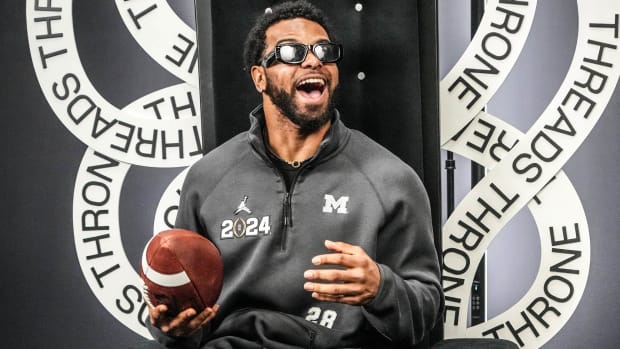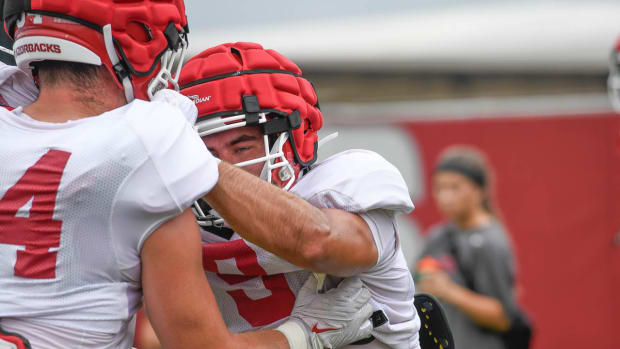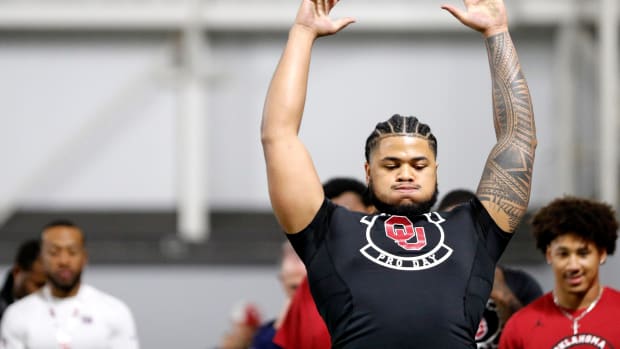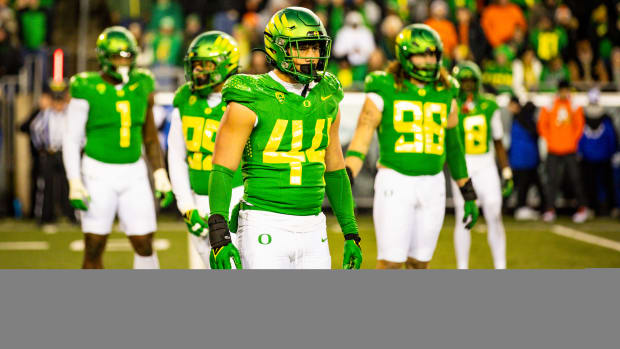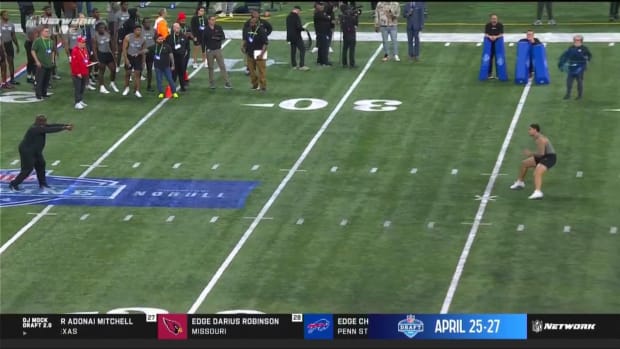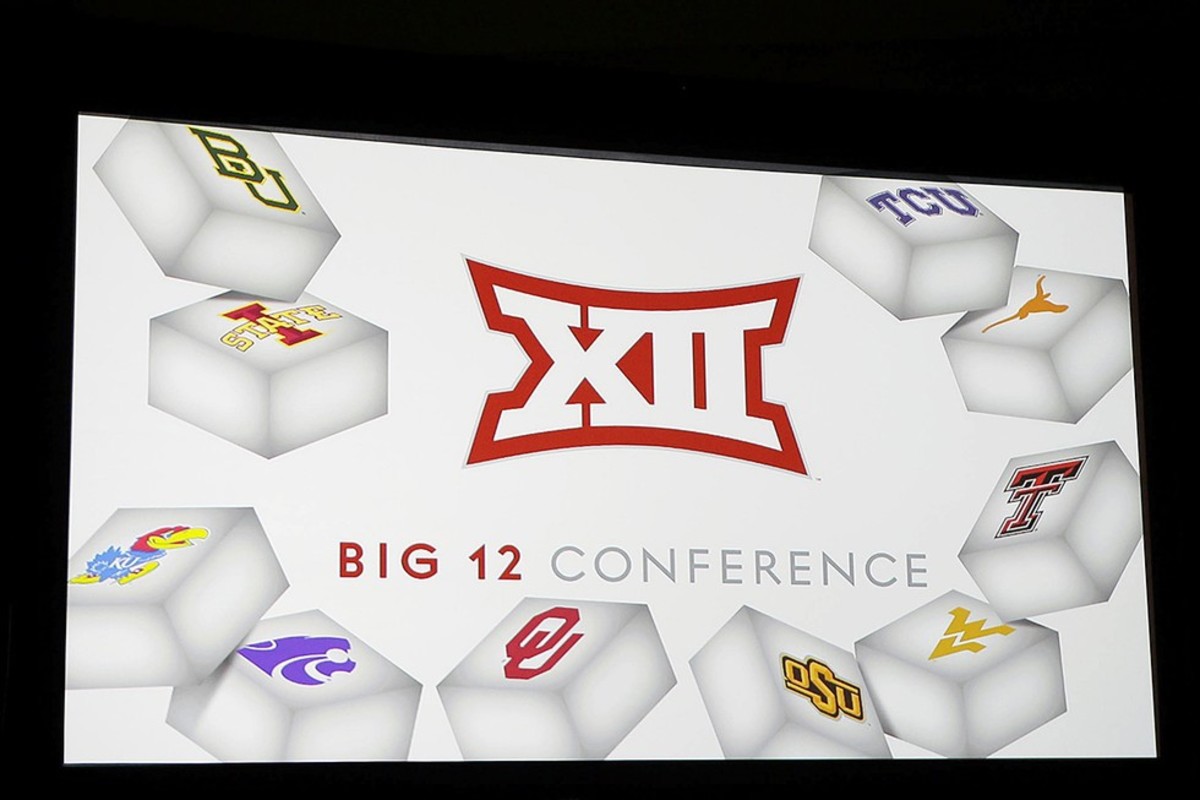
Ranking the best options for conference expansion in the always chaotic Big 12; Punt, Pass & Pork
[video: 13724861]
Commissioner Bob Bowlsby was answering a question last week about the fallout from the scandal at Baylor when he spoke these words, but they could be repurposed to serve as the Big 12's motto.
"To say that we have a vision for what the end game is," Bowlsby said, "would not be accurate."
A shotgun wedding during a period of realignment upheaval 20 years ago created this dysfunctional family, and now the league's presidents plan to enlarge it either to secure its future or to make one last furious cash grab before it explodes. Which is it? They don't know. That would require a vision for the end game. And even if the Big 12 presidents have some clue what that end game is, they probably can't agree upon it. This is, after all, the Big 12.
What we do know is the presidents authorized Bowlsby to evaluate candidates for expansion even though no combination of the schools apparently available to the Big 12 can help secure the league's future long-term. We also know that ACC commissioner John Swofford, who is a ninja and who did help secure the long-term future of his league by expanding, never announced when he planned to take schools. He just took them. But the Big 12 doesn't operate that way. Everything must be a spectacle, including the politicking created by the expansion announcement.
Evaluating the merits of potential candidates requires at least some idea of the ultimate goal, and there are a few possibilities …
• Possibility No. 1: All the Big 12 members, including Texas and Oklahoma, are being completely honest when they express a desire to stay together. They were aware that the ACC's deal with ESPN to create the ACC Network extended the ACC's grant of rights through the 2035–36 school year. (A grant of rights means the schools turn over their media rights to the conference, effectively tethering the schools to that conference for the term of the deal. Four Power 5 leagues have a grant of rights. The SEC doesn't because who is going to leave the SEC?) The Big 12 members, particularly the ones that would be left out of the power conferences if Texas and Oklahoma ever decided to leave, want some of that long-term security they saw the ACC get. They think network partners ESPN and Fox would be more willing to negotiate a new term of their deals if the league expands, so they agree to expand.
This is the least nefarious possibility. It also probably is the most likely possibility. Texas gets to keep the Longhorn Network. Oklahoma gets the bigger league for which president David Boren advocated. Both get to be in charge. Big 12 schools still make more from their league than Pac-12 schools make from theirs, which could be interesting when the Pac-12's media rights deals expire.
THAMEL: Early favorites emerge in Big 12 expansion discussion
The question is whether Fox and ESPN, which are contractually bound to kick in an amount equal to what each Big 12 school makes now for each new school, are willing to extend the deal past its current expiration date when none of the expansion candidates stir the blood. One X-factor is whether any of these new additions helps the football product, particularly as it relates to the College Football Playoff. If the Big 12 puts a team in the playoff every year between now and the end of the TV deals and wins a national title or two, the perception of the league could be quite different at that point.
• Possibility No. 2: The other eight members fear Texas and Oklahoma will split once the current media rights deals expire at the end of the 2024–25 school year and have agreed to take whatever schools will make the Longhorns and Sooners happy so they'll stick around. If it works, those schools get to keep enjoying power conference membership. If it doesn't, they did everything they could.
• Possibility No. 3: The other eight members suspect that Texas and Oklahoma are already gone and plan to use the pro rata provision in the contract for one last payday before they face the possibility of fending for themselves in the Group of Five hinterlands. (Some would wind up in power conferences anyway. Oklahoma State, for example, would be a prudent choice to come along with Oklahoma if the Sooners joined the SEC.)
Fox and ESPN have to pay the same amount per school regardless of membership total, but the Big 12 doesn't have to pass along all that money to new members. Most leagues don't grant a full share to new members anyway, but the Big 12 could essentially take bids for how little each school would take. Spoiler alert: Each school would take $1 more than it gets in its current league. This is the easiest The Price Is Right game ever conceived.
In this scenario, the Big 12 could add four schools and the current members could split up most of the cash. Heck, the Big 12 could take 10 new members. The newbies could split $50 million of the cash Fox and ESPN must pay each year and the existing schools could split the other $150 million. Of course, neither Fox nor ESPN would want to deal with the conference going forward, and everyone who didn't have a power conference landing spot would get blackballed by the two entities that fund much of major college sports.
Since Possibility No. 1 is the least far-fetched, let's rank* the candidates assuming the parameters outlined above. It's still unclear whether the league would add two schools or four, but we should assume that adding four will tick off the executives at Fox and ESPN, who aren't exactly excited about paying for two more schools.
*I may continue to rank the candidates every week until the Big 12 presidents decide what they want to do. Fair warning: Changes to the rankings likely would be completely arbitrary. No one knows what the plan is here.
VOTE: Which schools should the Big 12 add?
1. Cincinnati
The Bearcats would work if the Big 12 were starting a network and needed to acquire territory or if the league simply needed to add brand names. The conference network is probably out because Texas isn't likely to give up the Longhorn Network, so let's focus on the other factors.
Cincinnati has a devoted fan base in a largish city, and it would make an excellent eastern-fringe partner for West Virginia. The Bearcats have enjoyed recent football success, and they have a good men's basketball program. Playing in a power conference should allow Cincinnati to get even better at football. The city is home to some of the nation's best high school programs, and while Ohio State is still going to get first choice in the state, a power conference option close to home could be more attractive than other Big Ten programs or SEC programs coming north.
[video: 13724861]
2. Houston
If we were going by the parameters established in Possibility No. 2, Houston would be the No. 1 choice. Last week, Texas president Greg Fenves and chancellor William McRaven voiced their support for Houston's candidacy. So did incoming Texas Tech president Lawrence Schovanec.
There are a few theories about this. One is that if Houston isn't voted in, the leaders at Houston's fellow state schools can go the Texas legislature and say, "Well, we did our best." Another possibility, reported by Brian Davis of the Austin American-Statesman, is that Texas helping Houston get into the Big 12 would encourage University of Houston officials to drop their opposition to potential University of Texas system expansion into Houston.
Based on the parameters established in Possibility No. 1, Houston is a good candidate but not the best one. The Cougars have a new stadium and an excellent football brand, but current Big 12 schools would not want a member school in the most fertile football recruiting ground in the league's footprint. That move would give players a Big 12 and an SEC option (Texas A&M) closer to home than any other Big 12 school.
Could Houston be competitive in the Big 12 with the ability to recruit as a Big 12 team? Absolutely. TCU was competitive by its third Big 12 season. Houston could have a similar trajectory.
3. BYU
The Cougars have the strongest football brand and the most devoted fan base of any of the candidates. They also would add a third time zone to the league and have a ban—which wouldn't affect football but would affect other sports—against playing on Sundays.
BYU's willingness to accept a football-only membership eliminates concerns about the Sunday ban. How would having an odd number of schools affect the rest of the Big 12 sports? Adding schools probably eliminates the double round-robin in basketball anyway, so it might not be terribly dramatic.
NIESEN: 425-pound Motekiai Langi has no idea what awaits him at BYU
4. Connecticut
While football drives these decisions, basketball still makes money. National championships also matter for conference prestige. Adding UConn all but guarantees national titles in women's hoops. Meanwhile, the UConn men have won four national titles since 1999.
The Huskies' football isn't completely hopeless, either. They did win the Big East in 2010.
5. Central Florida
If this expansion push was as forward-looking as Big 12 leaders claim, UCF would top the list. The school has a massive enrollment (63,000), which will therefore produce a huge alumni base in future years. UCF leaders have done an excellent job the past two decades turning the school from a commuter campus to a destination school.
The football team was horrible last year, but UCF officials would be quick to point out that their team beat the Big 12 champion (Baylor) in the Fiesta Bowl after the 2014 season. But if there is no network on the table, how interested would Big 12 members be in expanding into Florida?
6. Memphis
Geographically, this is the best fit besides Houston. But geography went out the window when the Big 12 added West Virginia.
7. Boise State
People like watching Boise State play football on television, which could intrigue the network partners. But, like BYU, the Broncos would make the Big 12 a three-time-zone league. Boise also is a haul for most Big 12 schools. The closest is Texas Tech, and it's still 1,048 miles as the crow flies from Lubbock to Boise. Of course, it's only 313 miles by air between Provo and Boise.
8. South Florida
USF isn't as big as UCF. It also doesn't have its own football stadium. It's in a big television market, but with no cable channel in the offing, that wouldn't really matter.
9. Colorado State
The Rams also might be more attractive in a cable network scenario. They are building a new stadium and have played well in football under Jim McElwain and Mike Bobo. But with no need for the Big 12 to acquire territory, Colorado State's brand probably isn't strong enough.
10. San Diego State
To take the Aztecs, the Big 12 would have to decide to be a truly nationwide conference. That would probably mean taking BYU or Boise State and having schools in all four time zones.
11. East Carolina
Big 12 school presidents probably would say the Pirates' brand simply isn't strong enough. But the mostly Texas-based Big 12 likely fears venturing into eastern North Carolina because all those brisket lovers might come back wondering why they can't find smoked whole hog anywhere.
[video: 13724861]
A random ranking
Last week's topic (songs named after the movie for which they were written) was probably unfairly tilted toward James Bond movies. But it made me realize that I have never ranked the Bond villains' henchpeople. That ends today.
1. Jaws; The Spy Who Loved Me, Moonraker (and not just because Richard Kiel was also great in Happy Gilmore)
2. Odd Job; Goldfinger
3. May Day; A View To A Kill
4. Xenia Onatopp; Goldeneye
5. Mr. Wint and Mr. Kidd; Diamonds are Forever
First-and-10
1. In stable conference news, the ACC and ESPN announced last week that the ACC Network will launch in 2019 with a digital network launching this year. The conference and the network had been in serious discussions since 2013, and commissioner John Swofford broached the subject with media consultant Dean Jordan as far back as 2009. All told, this is the final of the ninja moves Swofford began making in 2003 to create long-term stability for a league that could have just as easily been ripped apart like the Big East was. On Saturday, Andrew Carter of The News and Observer in Raleigh, N.C., published an excellent story about how the ACC Network finally came together.
2. TCU coach Gary Patterson said in an interview with Chris Carlin and myself on SiriusXM's College Sports Nation last week that he'd like to see the playoff expand to either six or eight teams.
3. A Florida walk-on linebacker helped stop a rape behind a popular Gainesville bar.
4. A UCF receiver chased down and tackled a man suspected of filming women in a campus bathroom.
5. Iowa defensive tackle Faith Ekakitie wrote a thoughtful Facebook post after he was mistaken for a robbery suspect by police while playing Pokemon Go.
6. Notre Dame revealed its uniforms last week for the Shamrock Series game against Army in San Antonio on Nov. 12.
CAMPUS RUSH: Ranking the 10 worst uniforms of all time
7. We see what you did there, The Citadel.
8. LSU fans can now drink their favorite team.
9. Jim Harbaugh stars in the video and provides the hook for this (not bad) hip-hop tribute to the Wolverines.
10. Who's got it worse than Michigan in the football music video department? Still Notre Dame, which will never live down the day it cut a check to Freekbass. (And no, the Irish still haven't managed to purge this atrocity from the web.)
What's eating Andy?
The news of the deaths of former Nebraska punter Sam Foltz and former Michigan State punter Mike Sadler in a car crash was an absolute gut punch. Rest in peace.
What's Andy eating?
My travels often take me past restaurant windows that advertise a wide variety of foods. These places, usually in smaller towns, are touting what they think potential customers might want. But smart diners know it's awfully tough for one place to serve the best burger, the best pizza, the best wings and the best spaghetti. That's why I tend to choose places that specialize. You're not putting in your 10,000 hours on pizza if you're also making burgers.
So it was with great trepidation last week that I tried The Cowfish, an upscale sushi burger bar. That's no misprint. Sushi. Burger. Bar.
I ate at the original in Charlotte, but the concept has proven so successful that the place has expanded to Raleigh, Atlanta and Orlando. But how? A sushi bar is one thing. A burger bar is another. A sushi burger bar doesn't sound like something that should work on any level.
Yet it does.
"Most folks look at me like I have snakes coming out of my ears," co-owner Marcus Hall told the Charlotte Observer's Helen Schwab before opening the Charlotte location in 2010. "They ask: 'How do you expect to market something like that?' and I say, 'Well, you just looked at me like I have snakes coming out of my ears: It should be easy.'"
The idea of serving burgers and sushi seems so incongruous, but diners at The Cowfish can order from a burger menu and a sushi menu. The Cowfish then doubles down by combining burgers and sushi into something completely different. As odd as it may seem, these are the dishes you want.
Andy Staples
You want the Blackened Tuna Nachos, which sushifies the loaded nachos available at your local T.G.I McScratchy's. Instead of cheese and ground beef on corn chips, wonton chips are kissed with crab rangoon dip and avocado salsa and topped with tomatoes and hunks of rare yellowfin tuna. No matter the concept, this would be among the best appetizers at any restaurant at this price point.
You want the The All-American Bacon Double Cheeseburgooshi, which burgerfies the spicy tuna roll available at your local sushi joint. Beef, bacon, red onion and white and yellow cheddar cheese are wrapped in soy paper and potato strings and then flash fried. They are then topped with ketchup, mustard, dill pickle and tomatoes. It's a bacon cheeseburger in sushi roll form. The gimmick wouldn't matter if it tasted terrible. (Remember, there are standard burgers on the menu.) But the fried soy paper and potato strings make for a richer, tastier bun. Meanwhile, the sushi packaging ensures that every bite includes each ingredient in the ideal proportions. This has always been sushi's design advantage over a burger or any other sandwich, and The Cowfish has found a way to make a burger that incorporates sushi's greatest attribute.
Andy Staples
This doesn't work as well in every case. The Nature Boy's WOOOOO-shi BuffalOOOOO-shi Roll, a sushified bison burger that includes fried green tomato and feta cheese, doesn't pop on the tongue as its ingredients suggest it should. But The Deliverance Roll—also known as Bar-B-Q-shi—uses that fried soy paper and potato strings "bun" to surround pulled pork, caramelized onion and barbecue sauce. It tastes like the most perfectly packed pulled pork sandwich ever created.
Not everything has to marry such differing styles, though. The Blackened Tuna Roll on the sushi menu (lump crabcake mix and cream cheese with tempura flakes, topped with tuna, avocado salsa and jalapeños) would fit right in at the more progressive sushi place in most towns. Meanwhile, the parmesan bacon truffle fries would be a hit at any burger bar.
Thanks to The Cowfish, I may duck into a few more places that claim mastery of varied styles. Perhaps I've been too closed-minded. Specialization usually yields better results, but it never yields a sushi roll that tastes like a bacon cheeseburger.


